University Microeconomics Report: Australian Housing Market Analysis
VerifiedAdded on 2022/08/14
|15
|3246
|19
Report
AI Summary
This report delves into the Australian housing market from a microeconomic perspective, examining the fluctuations in housing prices and the factors driving them. It begins by outlining the current housing market scenario, highlighting the volatility and affordability challenges, particularly in major cities like Sydney and Melbourne. The core of the report focuses on applying microeconomic concepts such as demand, supply, and elasticity to explain price movements. It explores the determinants of housing demand, including income, demographics, rental costs, interest rates, and credit availability, while also discussing supply-side constraints such as complex planning processes, infrastructure funding, and land ownership issues. The report further analyzes demand and supply elasticity and their influence on price changes. The report concludes with a concise overview of the interplay between demand, supply, and elasticity in shaping the dynamics of the Australian housing market. The report also includes references and a table of contents for easy navigation.
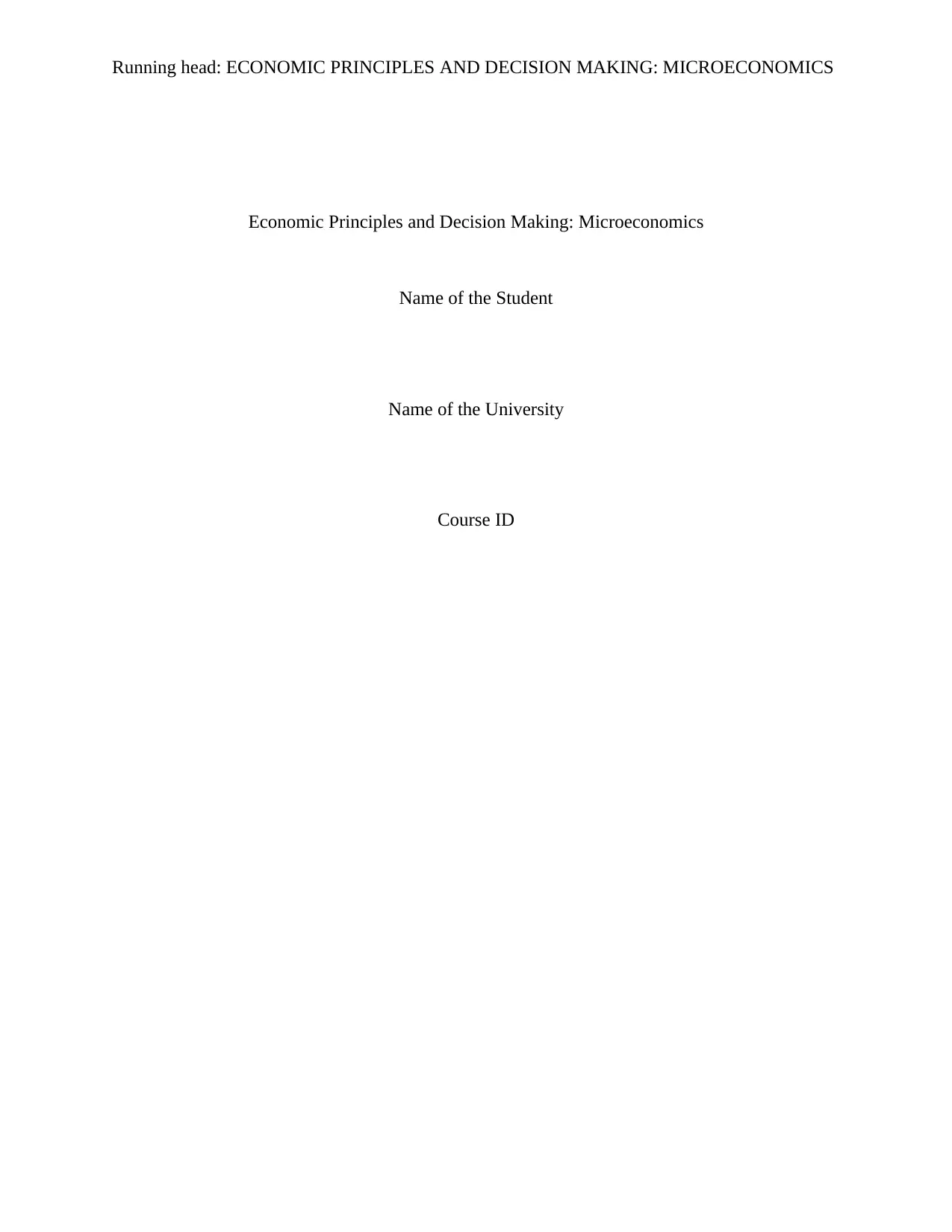
Running head: ECONOMIC PRINCIPLES AND DECISION MAKING: MICROECONOMICS
Economic Principles and Decision Making: Microeconomics
Name of the Student
Name of the University
Course ID
Economic Principles and Decision Making: Microeconomics
Name of the Student
Name of the University
Course ID
Paraphrase This Document
Need a fresh take? Get an instant paraphrase of this document with our AI Paraphraser
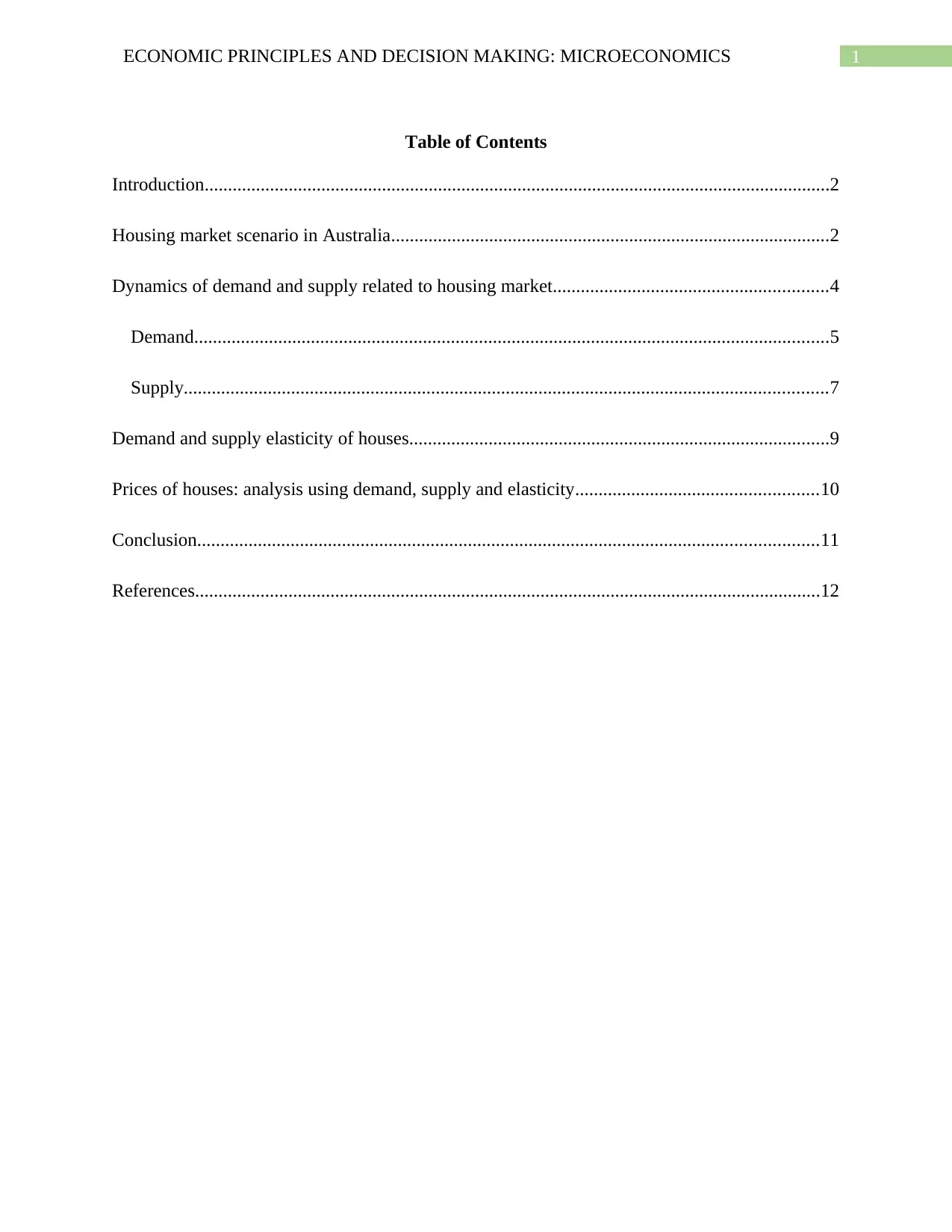
1ECONOMIC PRINCIPLES AND DECISION MAKING: MICROECONOMICS
Table of Contents
Introduction......................................................................................................................................2
Housing market scenario in Australia..............................................................................................2
Dynamics of demand and supply related to housing market...........................................................4
Demand........................................................................................................................................5
Supply..........................................................................................................................................7
Demand and supply elasticity of houses..........................................................................................9
Prices of houses: analysis using demand, supply and elasticity....................................................10
Conclusion.....................................................................................................................................11
References......................................................................................................................................12
Table of Contents
Introduction......................................................................................................................................2
Housing market scenario in Australia..............................................................................................2
Dynamics of demand and supply related to housing market...........................................................4
Demand........................................................................................................................................5
Supply..........................................................................................................................................7
Demand and supply elasticity of houses..........................................................................................9
Prices of houses: analysis using demand, supply and elasticity....................................................10
Conclusion.....................................................................................................................................11
References......................................................................................................................................12
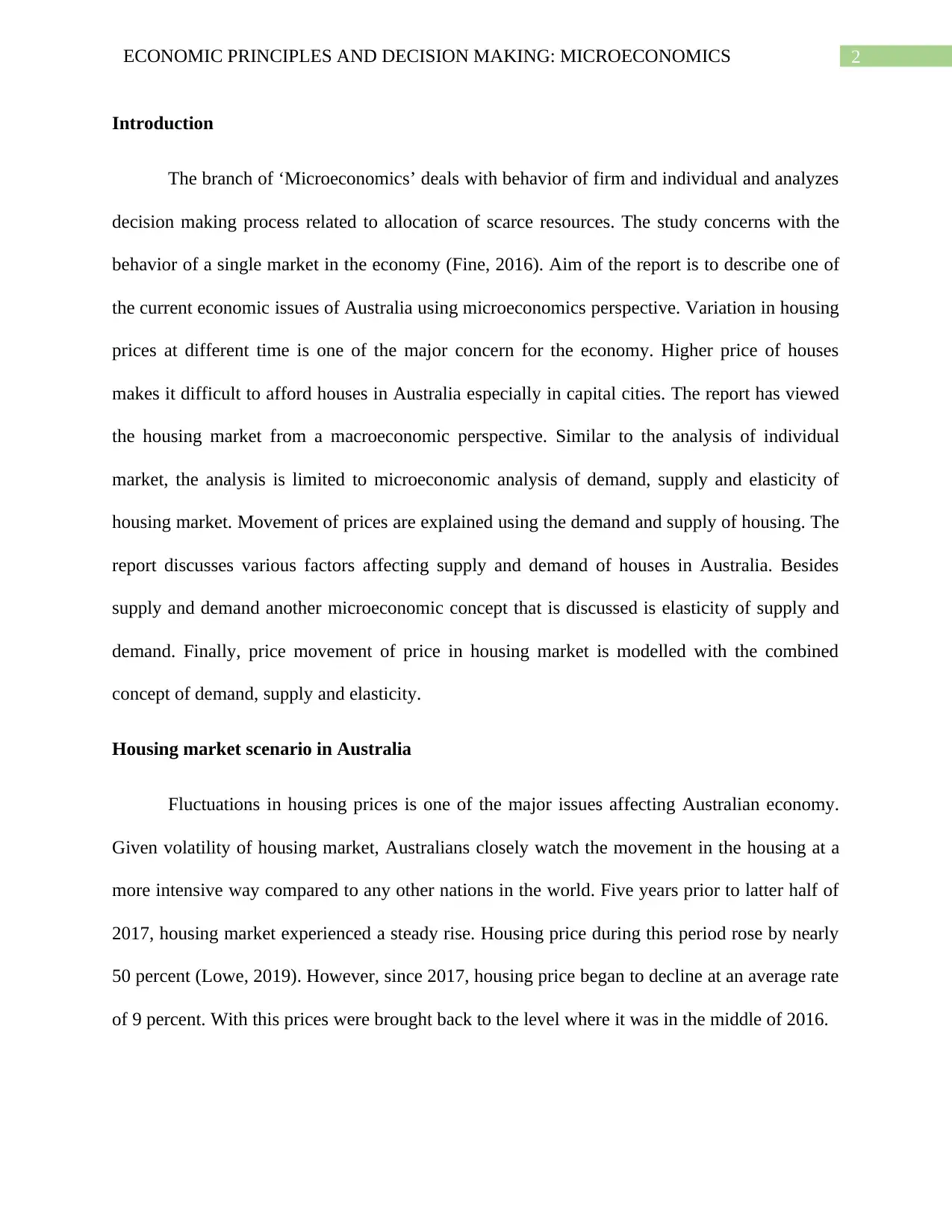
2ECONOMIC PRINCIPLES AND DECISION MAKING: MICROECONOMICS
Introduction
The branch of ‘Microeconomics’ deals with behavior of firm and individual and analyzes
decision making process related to allocation of scarce resources. The study concerns with the
behavior of a single market in the economy (Fine, 2016). Aim of the report is to describe one of
the current economic issues of Australia using microeconomics perspective. Variation in housing
prices at different time is one of the major concern for the economy. Higher price of houses
makes it difficult to afford houses in Australia especially in capital cities. The report has viewed
the housing market from a macroeconomic perspective. Similar to the analysis of individual
market, the analysis is limited to microeconomic analysis of demand, supply and elasticity of
housing market. Movement of prices are explained using the demand and supply of housing. The
report discusses various factors affecting supply and demand of houses in Australia. Besides
supply and demand another microeconomic concept that is discussed is elasticity of supply and
demand. Finally, price movement of price in housing market is modelled with the combined
concept of demand, supply and elasticity.
Housing market scenario in Australia
Fluctuations in housing prices is one of the major issues affecting Australian economy.
Given volatility of housing market, Australians closely watch the movement in the housing at a
more intensive way compared to any other nations in the world. Five years prior to latter half of
2017, housing market experienced a steady rise. Housing price during this period rose by nearly
50 percent (Lowe, 2019). However, since 2017, housing price began to decline at an average rate
of 9 percent. With this prices were brought back to the level where it was in the middle of 2016.
Introduction
The branch of ‘Microeconomics’ deals with behavior of firm and individual and analyzes
decision making process related to allocation of scarce resources. The study concerns with the
behavior of a single market in the economy (Fine, 2016). Aim of the report is to describe one of
the current economic issues of Australia using microeconomics perspective. Variation in housing
prices at different time is one of the major concern for the economy. Higher price of houses
makes it difficult to afford houses in Australia especially in capital cities. The report has viewed
the housing market from a macroeconomic perspective. Similar to the analysis of individual
market, the analysis is limited to microeconomic analysis of demand, supply and elasticity of
housing market. Movement of prices are explained using the demand and supply of housing. The
report discusses various factors affecting supply and demand of houses in Australia. Besides
supply and demand another microeconomic concept that is discussed is elasticity of supply and
demand. Finally, price movement of price in housing market is modelled with the combined
concept of demand, supply and elasticity.
Housing market scenario in Australia
Fluctuations in housing prices is one of the major issues affecting Australian economy.
Given volatility of housing market, Australians closely watch the movement in the housing at a
more intensive way compared to any other nations in the world. Five years prior to latter half of
2017, housing market experienced a steady rise. Housing price during this period rose by nearly
50 percent (Lowe, 2019). However, since 2017, housing price began to decline at an average rate
of 9 percent. With this prices were brought back to the level where it was in the middle of 2016.
⊘ This is a preview!⊘
Do you want full access?
Subscribe today to unlock all pages.

Trusted by 1+ million students worldwide
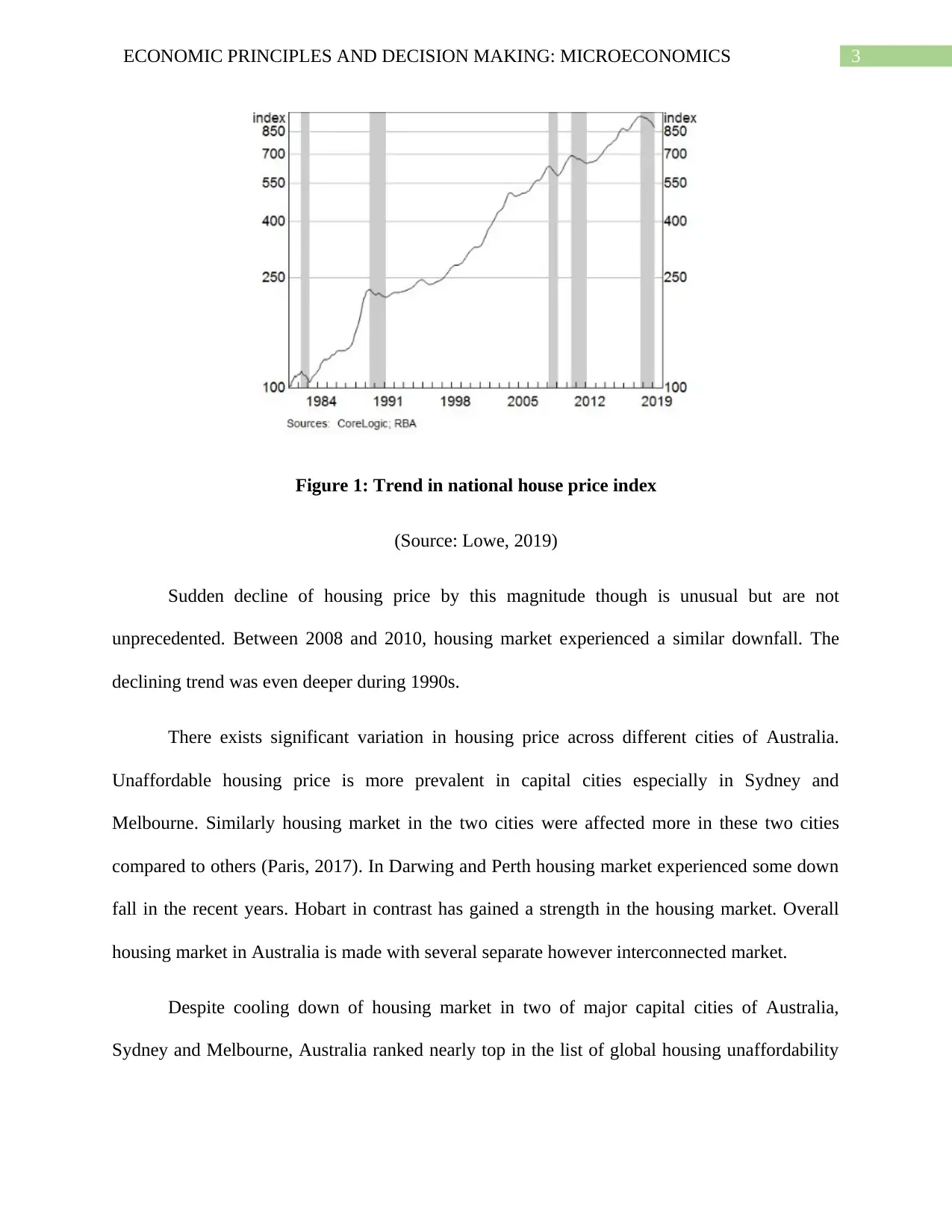
3ECONOMIC PRINCIPLES AND DECISION MAKING: MICROECONOMICS
Figure 1: Trend in national house price index
(Source: Lowe, 2019)
Sudden decline of housing price by this magnitude though is unusual but are not
unprecedented. Between 2008 and 2010, housing market experienced a similar downfall. The
declining trend was even deeper during 1990s.
There exists significant variation in housing price across different cities of Australia.
Unaffordable housing price is more prevalent in capital cities especially in Sydney and
Melbourne. Similarly housing market in the two cities were affected more in these two cities
compared to others (Paris, 2017). In Darwing and Perth housing market experienced some down
fall in the recent years. Hobart in contrast has gained a strength in the housing market. Overall
housing market in Australia is made with several separate however interconnected market.
Despite cooling down of housing market in two of major capital cities of Australia,
Sydney and Melbourne, Australia ranked nearly top in the list of global housing unaffordability
Figure 1: Trend in national house price index
(Source: Lowe, 2019)
Sudden decline of housing price by this magnitude though is unusual but are not
unprecedented. Between 2008 and 2010, housing market experienced a similar downfall. The
declining trend was even deeper during 1990s.
There exists significant variation in housing price across different cities of Australia.
Unaffordable housing price is more prevalent in capital cities especially in Sydney and
Melbourne. Similarly housing market in the two cities were affected more in these two cities
compared to others (Paris, 2017). In Darwing and Perth housing market experienced some down
fall in the recent years. Hobart in contrast has gained a strength in the housing market. Overall
housing market in Australia is made with several separate however interconnected market.
Despite cooling down of housing market in two of major capital cities of Australia,
Sydney and Melbourne, Australia ranked nearly top in the list of global housing unaffordability
Paraphrase This Document
Need a fresh take? Get an instant paraphrase of this document with our AI Paraphraser
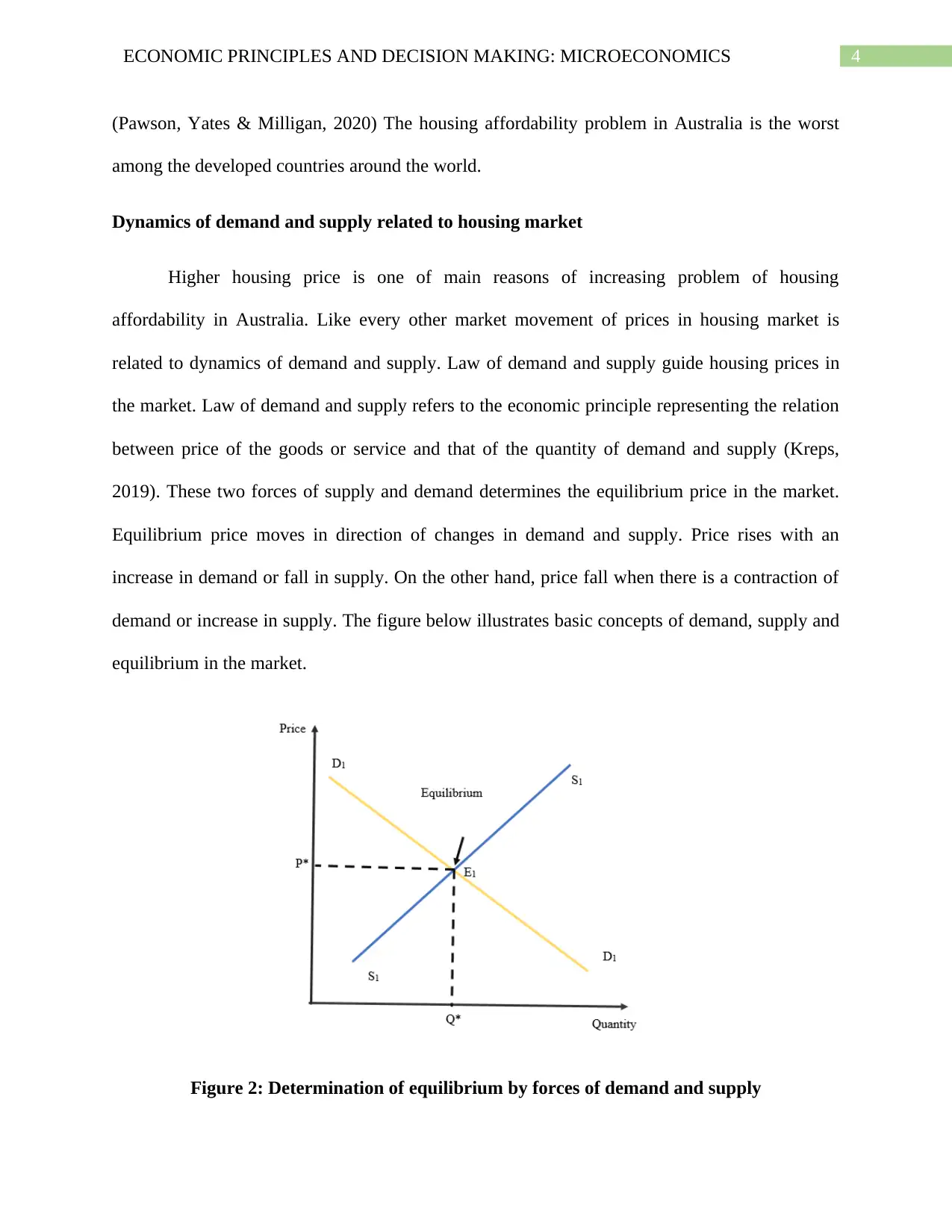
4ECONOMIC PRINCIPLES AND DECISION MAKING: MICROECONOMICS
(Pawson, Yates & Milligan, 2020) The housing affordability problem in Australia is the worst
among the developed countries around the world.
Dynamics of demand and supply related to housing market
Higher housing price is one of main reasons of increasing problem of housing
affordability in Australia. Like every other market movement of prices in housing market is
related to dynamics of demand and supply. Law of demand and supply guide housing prices in
the market. Law of demand and supply refers to the economic principle representing the relation
between price of the goods or service and that of the quantity of demand and supply (Kreps,
2019). These two forces of supply and demand determines the equilibrium price in the market.
Equilibrium price moves in direction of changes in demand and supply. Price rises with an
increase in demand or fall in supply. On the other hand, price fall when there is a contraction of
demand or increase in supply. The figure below illustrates basic concepts of demand, supply and
equilibrium in the market.
Figure 2: Determination of equilibrium by forces of demand and supply
(Pawson, Yates & Milligan, 2020) The housing affordability problem in Australia is the worst
among the developed countries around the world.
Dynamics of demand and supply related to housing market
Higher housing price is one of main reasons of increasing problem of housing
affordability in Australia. Like every other market movement of prices in housing market is
related to dynamics of demand and supply. Law of demand and supply guide housing prices in
the market. Law of demand and supply refers to the economic principle representing the relation
between price of the goods or service and that of the quantity of demand and supply (Kreps,
2019). These two forces of supply and demand determines the equilibrium price in the market.
Equilibrium price moves in direction of changes in demand and supply. Price rises with an
increase in demand or fall in supply. On the other hand, price fall when there is a contraction of
demand or increase in supply. The figure below illustrates basic concepts of demand, supply and
equilibrium in the market.
Figure 2: Determination of equilibrium by forces of demand and supply
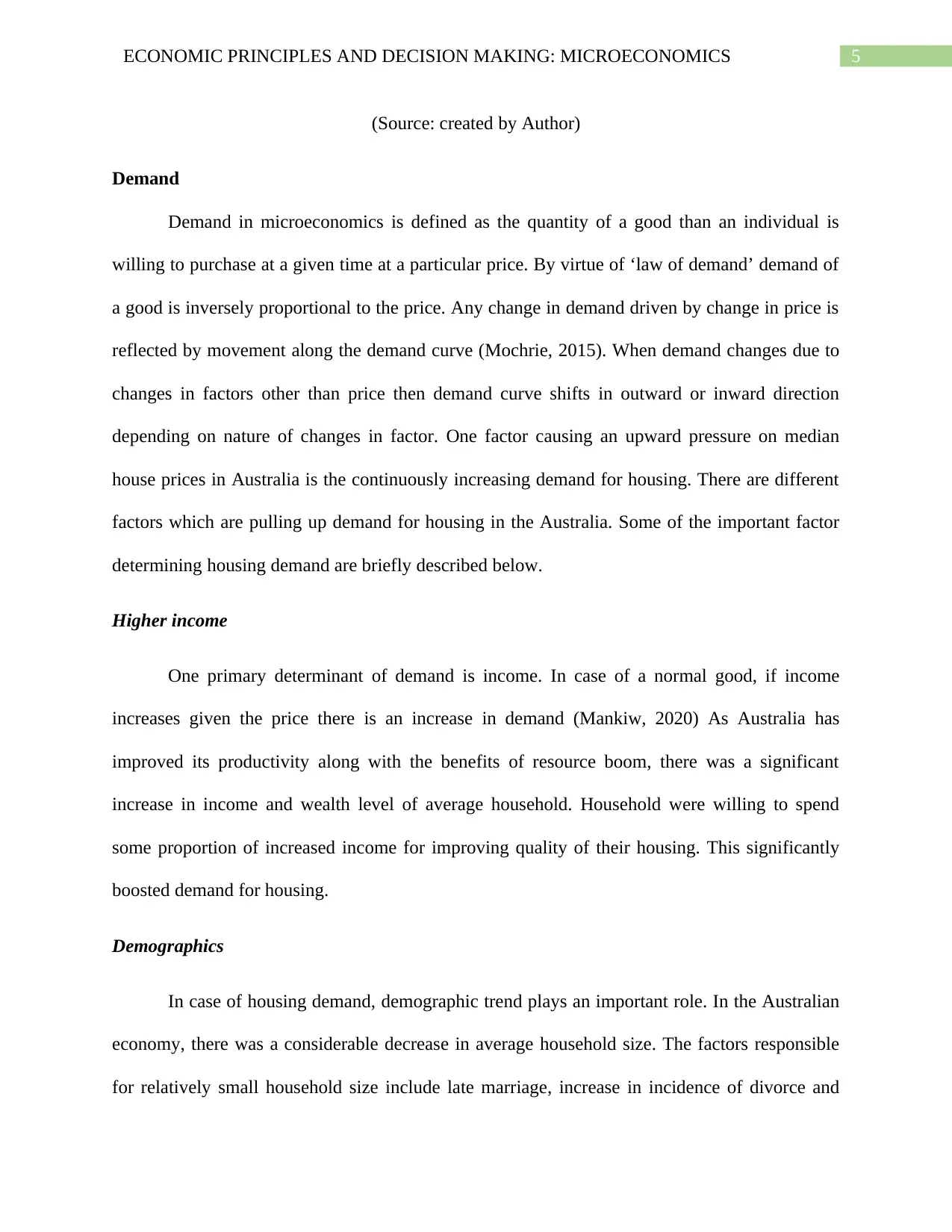
5ECONOMIC PRINCIPLES AND DECISION MAKING: MICROECONOMICS
(Source: created by Author)
Demand
Demand in microeconomics is defined as the quantity of a good than an individual is
willing to purchase at a given time at a particular price. By virtue of ‘law of demand’ demand of
a good is inversely proportional to the price. Any change in demand driven by change in price is
reflected by movement along the demand curve (Mochrie, 2015). When demand changes due to
changes in factors other than price then demand curve shifts in outward or inward direction
depending on nature of changes in factor. One factor causing an upward pressure on median
house prices in Australia is the continuously increasing demand for housing. There are different
factors which are pulling up demand for housing in the Australia. Some of the important factor
determining housing demand are briefly described below.
Higher income
One primary determinant of demand is income. In case of a normal good, if income
increases given the price there is an increase in demand (Mankiw, 2020) As Australia has
improved its productivity along with the benefits of resource boom, there was a significant
increase in income and wealth level of average household. Household were willing to spend
some proportion of increased income for improving quality of their housing. This significantly
boosted demand for housing.
Demographics
In case of housing demand, demographic trend plays an important role. In the Australian
economy, there was a considerable decrease in average household size. The factors responsible
for relatively small household size include late marriage, increase in incidence of divorce and
(Source: created by Author)
Demand
Demand in microeconomics is defined as the quantity of a good than an individual is
willing to purchase at a given time at a particular price. By virtue of ‘law of demand’ demand of
a good is inversely proportional to the price. Any change in demand driven by change in price is
reflected by movement along the demand curve (Mochrie, 2015). When demand changes due to
changes in factors other than price then demand curve shifts in outward or inward direction
depending on nature of changes in factor. One factor causing an upward pressure on median
house prices in Australia is the continuously increasing demand for housing. There are different
factors which are pulling up demand for housing in the Australia. Some of the important factor
determining housing demand are briefly described below.
Higher income
One primary determinant of demand is income. In case of a normal good, if income
increases given the price there is an increase in demand (Mankiw, 2020) As Australia has
improved its productivity along with the benefits of resource boom, there was a significant
increase in income and wealth level of average household. Household were willing to spend
some proportion of increased income for improving quality of their housing. This significantly
boosted demand for housing.
Demographics
In case of housing demand, demographic trend plays an important role. In the Australian
economy, there was a considerable decrease in average household size. The factors responsible
for relatively small household size include late marriage, increase in incidence of divorce and
⊘ This is a preview!⊘
Do you want full access?
Subscribe today to unlock all pages.

Trusted by 1+ million students worldwide
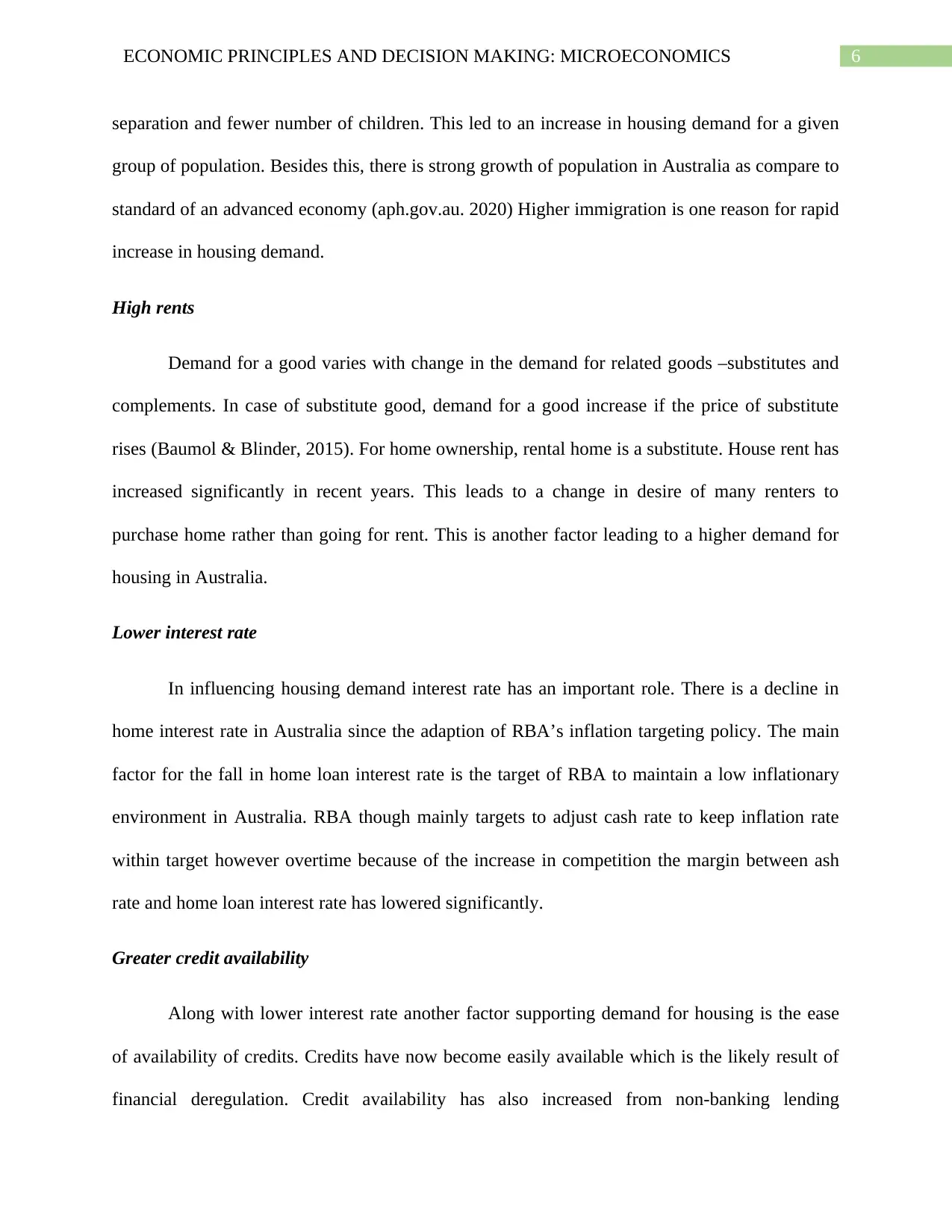
6ECONOMIC PRINCIPLES AND DECISION MAKING: MICROECONOMICS
separation and fewer number of children. This led to an increase in housing demand for a given
group of population. Besides this, there is strong growth of population in Australia as compare to
standard of an advanced economy (aph.gov.au. 2020) Higher immigration is one reason for rapid
increase in housing demand.
High rents
Demand for a good varies with change in the demand for related goods –substitutes and
complements. In case of substitute good, demand for a good increase if the price of substitute
rises (Baumol & Blinder, 2015). For home ownership, rental home is a substitute. House rent has
increased significantly in recent years. This leads to a change in desire of many renters to
purchase home rather than going for rent. This is another factor leading to a higher demand for
housing in Australia.
Lower interest rate
In influencing housing demand interest rate has an important role. There is a decline in
home interest rate in Australia since the adaption of RBA’s inflation targeting policy. The main
factor for the fall in home loan interest rate is the target of RBA to maintain a low inflationary
environment in Australia. RBA though mainly targets to adjust cash rate to keep inflation rate
within target however overtime because of the increase in competition the margin between ash
rate and home loan interest rate has lowered significantly.
Greater credit availability
Along with lower interest rate another factor supporting demand for housing is the ease
of availability of credits. Credits have now become easily available which is the likely result of
financial deregulation. Credit availability has also increased from non-banking lending
separation and fewer number of children. This led to an increase in housing demand for a given
group of population. Besides this, there is strong growth of population in Australia as compare to
standard of an advanced economy (aph.gov.au. 2020) Higher immigration is one reason for rapid
increase in housing demand.
High rents
Demand for a good varies with change in the demand for related goods –substitutes and
complements. In case of substitute good, demand for a good increase if the price of substitute
rises (Baumol & Blinder, 2015). For home ownership, rental home is a substitute. House rent has
increased significantly in recent years. This leads to a change in desire of many renters to
purchase home rather than going for rent. This is another factor leading to a higher demand for
housing in Australia.
Lower interest rate
In influencing housing demand interest rate has an important role. There is a decline in
home interest rate in Australia since the adaption of RBA’s inflation targeting policy. The main
factor for the fall in home loan interest rate is the target of RBA to maintain a low inflationary
environment in Australia. RBA though mainly targets to adjust cash rate to keep inflation rate
within target however overtime because of the increase in competition the margin between ash
rate and home loan interest rate has lowered significantly.
Greater credit availability
Along with lower interest rate another factor supporting demand for housing is the ease
of availability of credits. Credits have now become easily available which is the likely result of
financial deregulation. Credit availability has also increased from non-banking lending
Paraphrase This Document
Need a fresh take? Get an instant paraphrase of this document with our AI Paraphraser
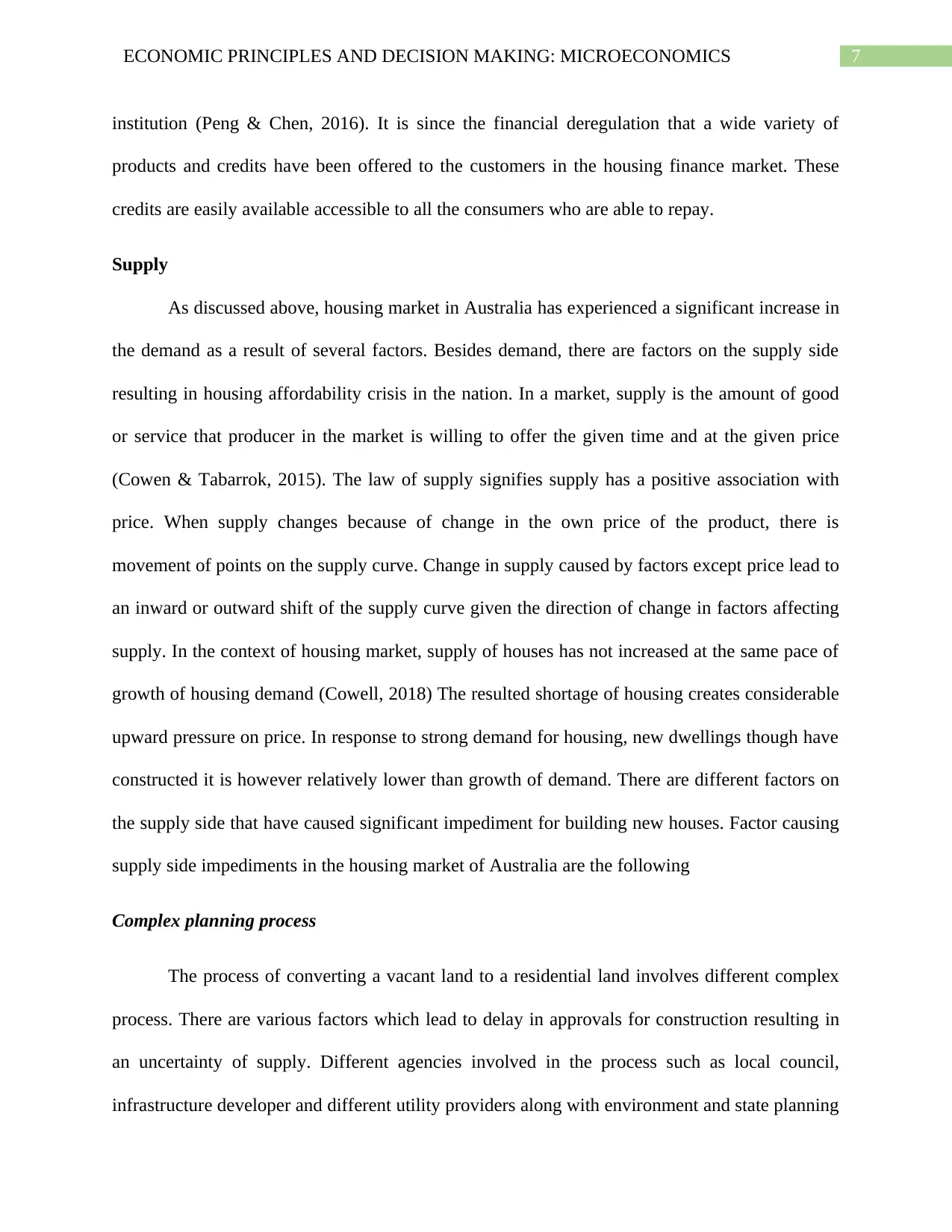
7ECONOMIC PRINCIPLES AND DECISION MAKING: MICROECONOMICS
institution (Peng & Chen, 2016). It is since the financial deregulation that a wide variety of
products and credits have been offered to the customers in the housing finance market. These
credits are easily available accessible to all the consumers who are able to repay.
Supply
As discussed above, housing market in Australia has experienced a significant increase in
the demand as a result of several factors. Besides demand, there are factors on the supply side
resulting in housing affordability crisis in the nation. In a market, supply is the amount of good
or service that producer in the market is willing to offer the given time and at the given price
(Cowen & Tabarrok, 2015). The law of supply signifies supply has a positive association with
price. When supply changes because of change in the own price of the product, there is
movement of points on the supply curve. Change in supply caused by factors except price lead to
an inward or outward shift of the supply curve given the direction of change in factors affecting
supply. In the context of housing market, supply of houses has not increased at the same pace of
growth of housing demand (Cowell, 2018) The resulted shortage of housing creates considerable
upward pressure on price. In response to strong demand for housing, new dwellings though have
constructed it is however relatively lower than growth of demand. There are different factors on
the supply side that have caused significant impediment for building new houses. Factor causing
supply side impediments in the housing market of Australia are the following
Complex planning process
The process of converting a vacant land to a residential land involves different complex
process. There are various factors which lead to delay in approvals for construction resulting in
an uncertainty of supply. Different agencies involved in the process such as local council,
infrastructure developer and different utility providers along with environment and state planning
institution (Peng & Chen, 2016). It is since the financial deregulation that a wide variety of
products and credits have been offered to the customers in the housing finance market. These
credits are easily available accessible to all the consumers who are able to repay.
Supply
As discussed above, housing market in Australia has experienced a significant increase in
the demand as a result of several factors. Besides demand, there are factors on the supply side
resulting in housing affordability crisis in the nation. In a market, supply is the amount of good
or service that producer in the market is willing to offer the given time and at the given price
(Cowen & Tabarrok, 2015). The law of supply signifies supply has a positive association with
price. When supply changes because of change in the own price of the product, there is
movement of points on the supply curve. Change in supply caused by factors except price lead to
an inward or outward shift of the supply curve given the direction of change in factors affecting
supply. In the context of housing market, supply of houses has not increased at the same pace of
growth of housing demand (Cowell, 2018) The resulted shortage of housing creates considerable
upward pressure on price. In response to strong demand for housing, new dwellings though have
constructed it is however relatively lower than growth of demand. There are different factors on
the supply side that have caused significant impediment for building new houses. Factor causing
supply side impediments in the housing market of Australia are the following
Complex planning process
The process of converting a vacant land to a residential land involves different complex
process. There are various factors which lead to delay in approvals for construction resulting in
an uncertainty of supply. Different agencies involved in the process such as local council,
infrastructure developer and different utility providers along with environment and state planning
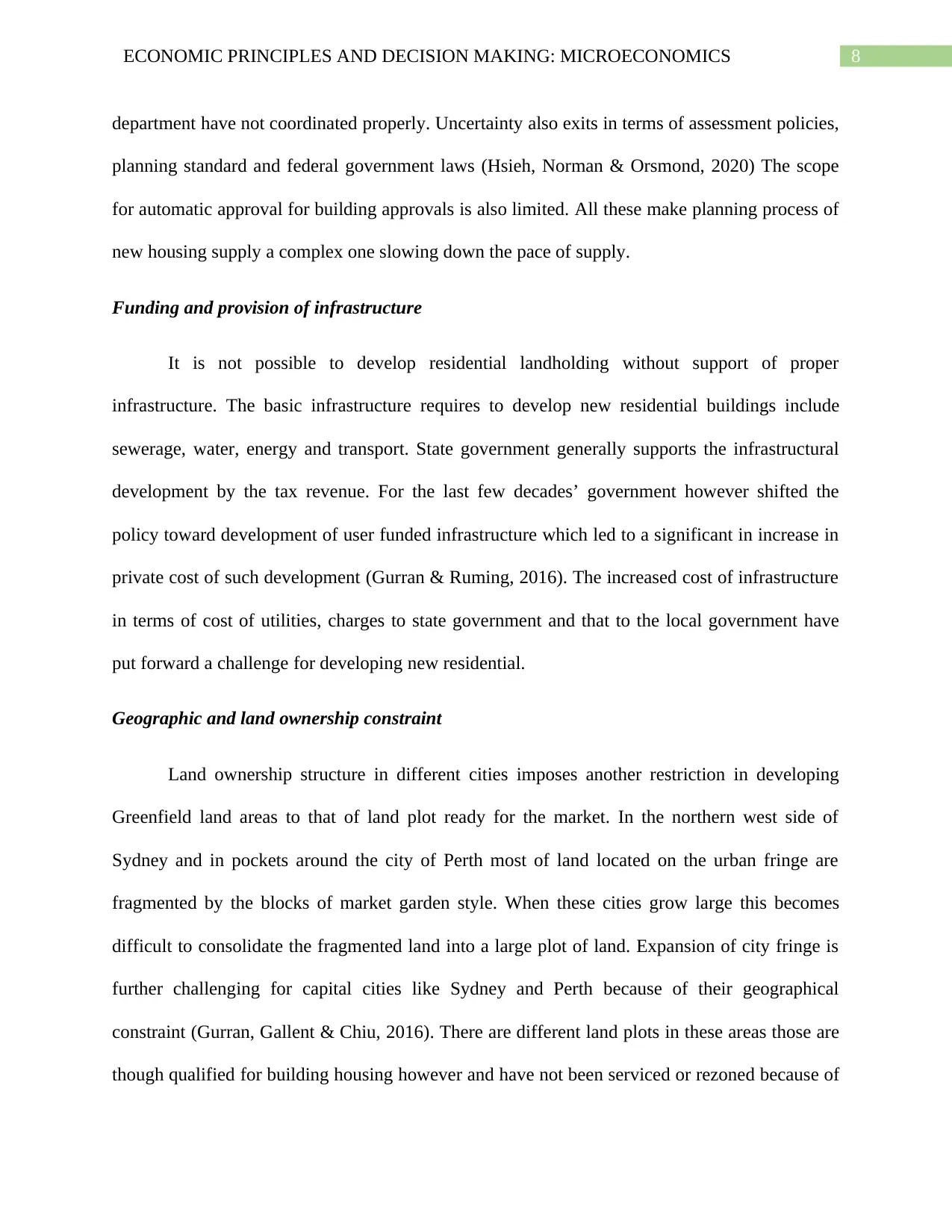
8ECONOMIC PRINCIPLES AND DECISION MAKING: MICROECONOMICS
department have not coordinated properly. Uncertainty also exits in terms of assessment policies,
planning standard and federal government laws (Hsieh, Norman & Orsmond, 2020) The scope
for automatic approval for building approvals is also limited. All these make planning process of
new housing supply a complex one slowing down the pace of supply.
Funding and provision of infrastructure
It is not possible to develop residential landholding without support of proper
infrastructure. The basic infrastructure requires to develop new residential buildings include
sewerage, water, energy and transport. State government generally supports the infrastructural
development by the tax revenue. For the last few decades’ government however shifted the
policy toward development of user funded infrastructure which led to a significant in increase in
private cost of such development (Gurran & Ruming, 2016). The increased cost of infrastructure
in terms of cost of utilities, charges to state government and that to the local government have
put forward a challenge for developing new residential.
Geographic and land ownership constraint
Land ownership structure in different cities imposes another restriction in developing
Greenfield land areas to that of land plot ready for the market. In the northern west side of
Sydney and in pockets around the city of Perth most of land located on the urban fringe are
fragmented by the blocks of market garden style. When these cities grow large this becomes
difficult to consolidate the fragmented land into a large plot of land. Expansion of city fringe is
further challenging for capital cities like Sydney and Perth because of their geographical
constraint (Gurran, Gallent & Chiu, 2016). There are different land plots in these areas those are
though qualified for building housing however and have not been serviced or rezoned because of
department have not coordinated properly. Uncertainty also exits in terms of assessment policies,
planning standard and federal government laws (Hsieh, Norman & Orsmond, 2020) The scope
for automatic approval for building approvals is also limited. All these make planning process of
new housing supply a complex one slowing down the pace of supply.
Funding and provision of infrastructure
It is not possible to develop residential landholding without support of proper
infrastructure. The basic infrastructure requires to develop new residential buildings include
sewerage, water, energy and transport. State government generally supports the infrastructural
development by the tax revenue. For the last few decades’ government however shifted the
policy toward development of user funded infrastructure which led to a significant in increase in
private cost of such development (Gurran & Ruming, 2016). The increased cost of infrastructure
in terms of cost of utilities, charges to state government and that to the local government have
put forward a challenge for developing new residential.
Geographic and land ownership constraint
Land ownership structure in different cities imposes another restriction in developing
Greenfield land areas to that of land plot ready for the market. In the northern west side of
Sydney and in pockets around the city of Perth most of land located on the urban fringe are
fragmented by the blocks of market garden style. When these cities grow large this becomes
difficult to consolidate the fragmented land into a large plot of land. Expansion of city fringe is
further challenging for capital cities like Sydney and Perth because of their geographical
constraint (Gurran, Gallent & Chiu, 2016). There are different land plots in these areas those are
though qualified for building housing however and have not been serviced or rezoned because of
⊘ This is a preview!⊘
Do you want full access?
Subscribe today to unlock all pages.

Trusted by 1+ million students worldwide
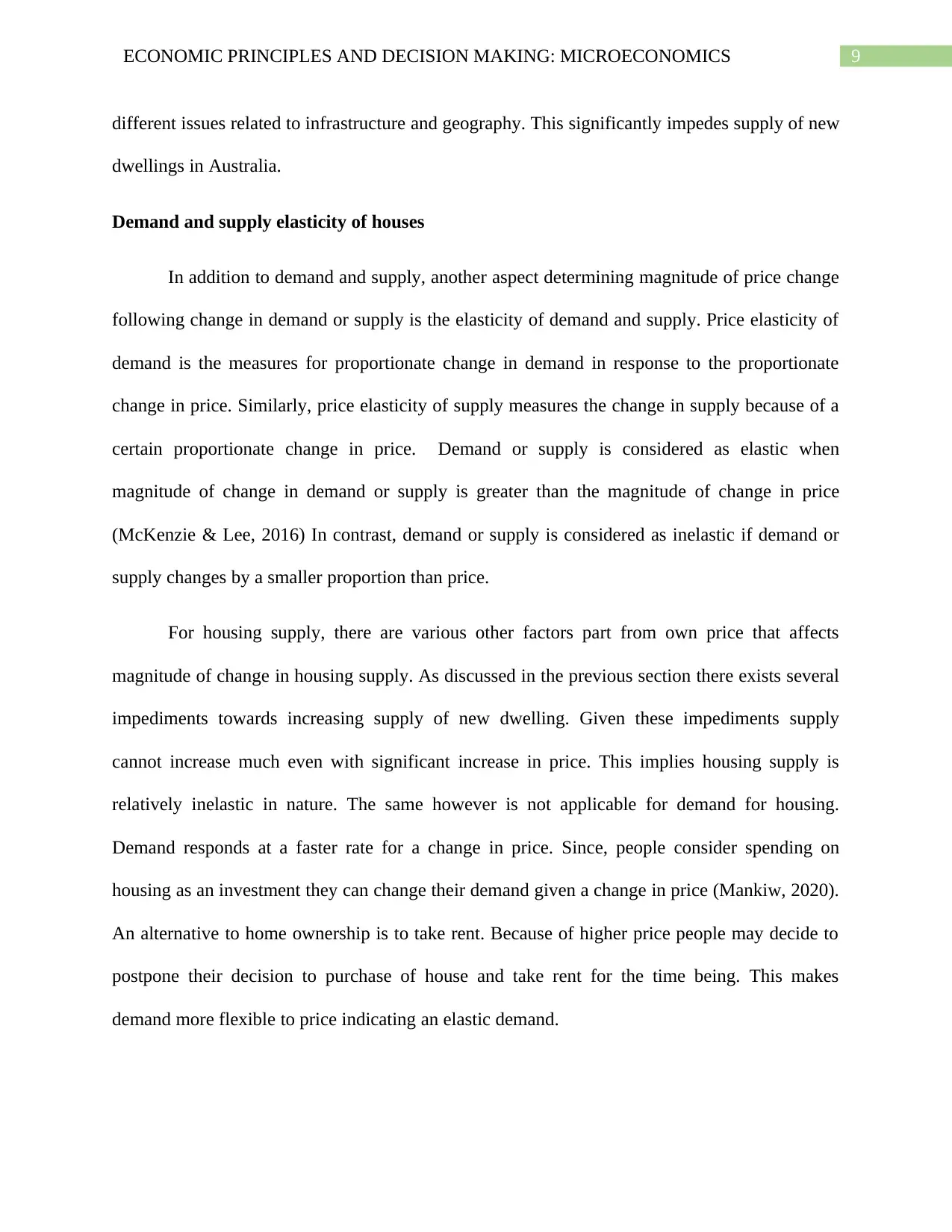
9ECONOMIC PRINCIPLES AND DECISION MAKING: MICROECONOMICS
different issues related to infrastructure and geography. This significantly impedes supply of new
dwellings in Australia.
Demand and supply elasticity of houses
In addition to demand and supply, another aspect determining magnitude of price change
following change in demand or supply is the elasticity of demand and supply. Price elasticity of
demand is the measures for proportionate change in demand in response to the proportionate
change in price. Similarly, price elasticity of supply measures the change in supply because of a
certain proportionate change in price. Demand or supply is considered as elastic when
magnitude of change in demand or supply is greater than the magnitude of change in price
(McKenzie & Lee, 2016) In contrast, demand or supply is considered as inelastic if demand or
supply changes by a smaller proportion than price.
For housing supply, there are various other factors part from own price that affects
magnitude of change in housing supply. As discussed in the previous section there exists several
impediments towards increasing supply of new dwelling. Given these impediments supply
cannot increase much even with significant increase in price. This implies housing supply is
relatively inelastic in nature. The same however is not applicable for demand for housing.
Demand responds at a faster rate for a change in price. Since, people consider spending on
housing as an investment they can change their demand given a change in price (Mankiw, 2020).
An alternative to home ownership is to take rent. Because of higher price people may decide to
postpone their decision to purchase of house and take rent for the time being. This makes
demand more flexible to price indicating an elastic demand.
different issues related to infrastructure and geography. This significantly impedes supply of new
dwellings in Australia.
Demand and supply elasticity of houses
In addition to demand and supply, another aspect determining magnitude of price change
following change in demand or supply is the elasticity of demand and supply. Price elasticity of
demand is the measures for proportionate change in demand in response to the proportionate
change in price. Similarly, price elasticity of supply measures the change in supply because of a
certain proportionate change in price. Demand or supply is considered as elastic when
magnitude of change in demand or supply is greater than the magnitude of change in price
(McKenzie & Lee, 2016) In contrast, demand or supply is considered as inelastic if demand or
supply changes by a smaller proportion than price.
For housing supply, there are various other factors part from own price that affects
magnitude of change in housing supply. As discussed in the previous section there exists several
impediments towards increasing supply of new dwelling. Given these impediments supply
cannot increase much even with significant increase in price. This implies housing supply is
relatively inelastic in nature. The same however is not applicable for demand for housing.
Demand responds at a faster rate for a change in price. Since, people consider spending on
housing as an investment they can change their demand given a change in price (Mankiw, 2020).
An alternative to home ownership is to take rent. Because of higher price people may decide to
postpone their decision to purchase of house and take rent for the time being. This makes
demand more flexible to price indicating an elastic demand.
Paraphrase This Document
Need a fresh take? Get an instant paraphrase of this document with our AI Paraphraser
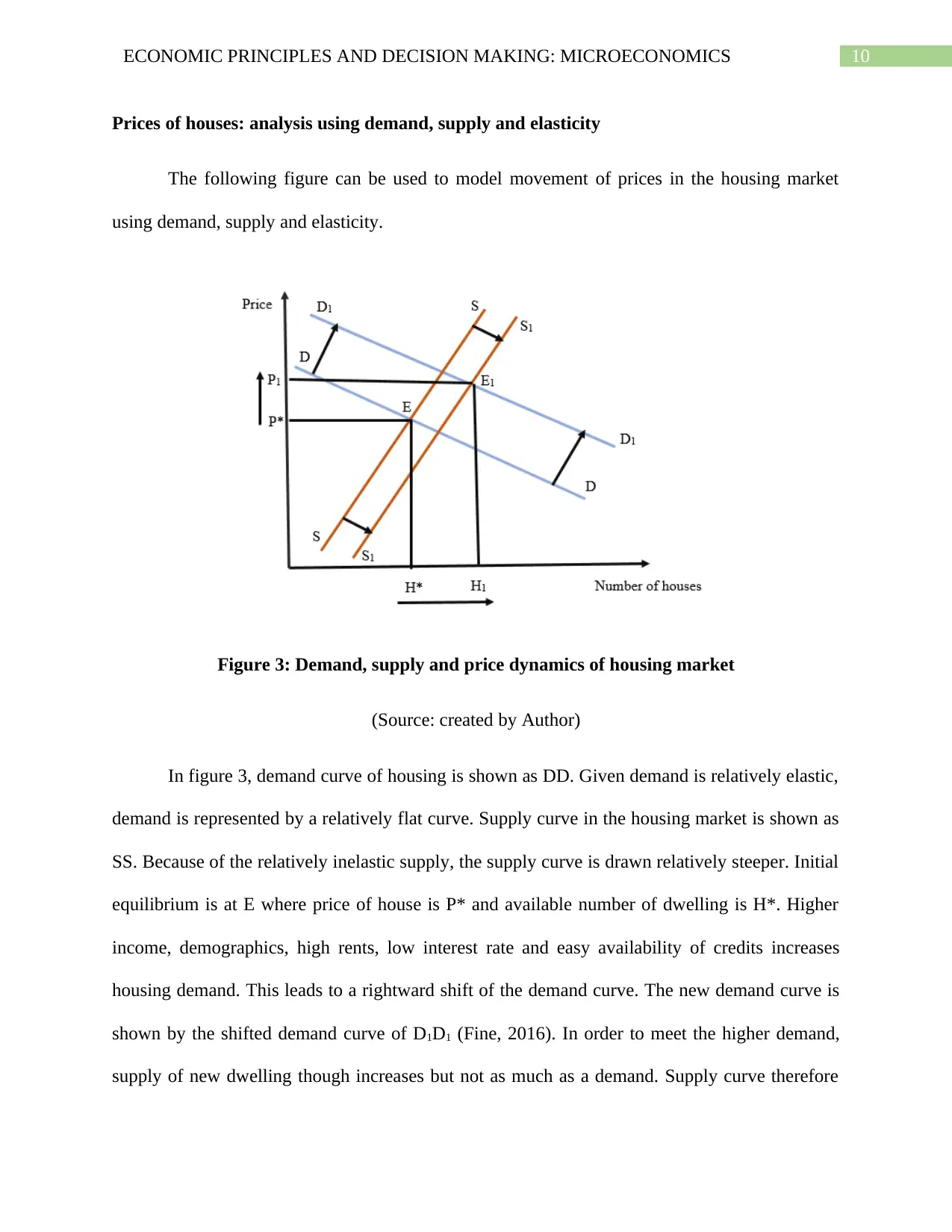
10ECONOMIC PRINCIPLES AND DECISION MAKING: MICROECONOMICS
Prices of houses: analysis using demand, supply and elasticity
The following figure can be used to model movement of prices in the housing market
using demand, supply and elasticity.
Figure 3: Demand, supply and price dynamics of housing market
(Source: created by Author)
In figure 3, demand curve of housing is shown as DD. Given demand is relatively elastic,
demand is represented by a relatively flat curve. Supply curve in the housing market is shown as
SS. Because of the relatively inelastic supply, the supply curve is drawn relatively steeper. Initial
equilibrium is at E where price of house is P* and available number of dwelling is H*. Higher
income, demographics, high rents, low interest rate and easy availability of credits increases
housing demand. This leads to a rightward shift of the demand curve. The new demand curve is
shown by the shifted demand curve of D1D1 (Fine, 2016). In order to meet the higher demand,
supply of new dwelling though increases but not as much as a demand. Supply curve therefore
Prices of houses: analysis using demand, supply and elasticity
The following figure can be used to model movement of prices in the housing market
using demand, supply and elasticity.
Figure 3: Demand, supply and price dynamics of housing market
(Source: created by Author)
In figure 3, demand curve of housing is shown as DD. Given demand is relatively elastic,
demand is represented by a relatively flat curve. Supply curve in the housing market is shown as
SS. Because of the relatively inelastic supply, the supply curve is drawn relatively steeper. Initial
equilibrium is at E where price of house is P* and available number of dwelling is H*. Higher
income, demographics, high rents, low interest rate and easy availability of credits increases
housing demand. This leads to a rightward shift of the demand curve. The new demand curve is
shown by the shifted demand curve of D1D1 (Fine, 2016). In order to meet the higher demand,
supply of new dwelling though increases but not as much as a demand. Supply curve therefore
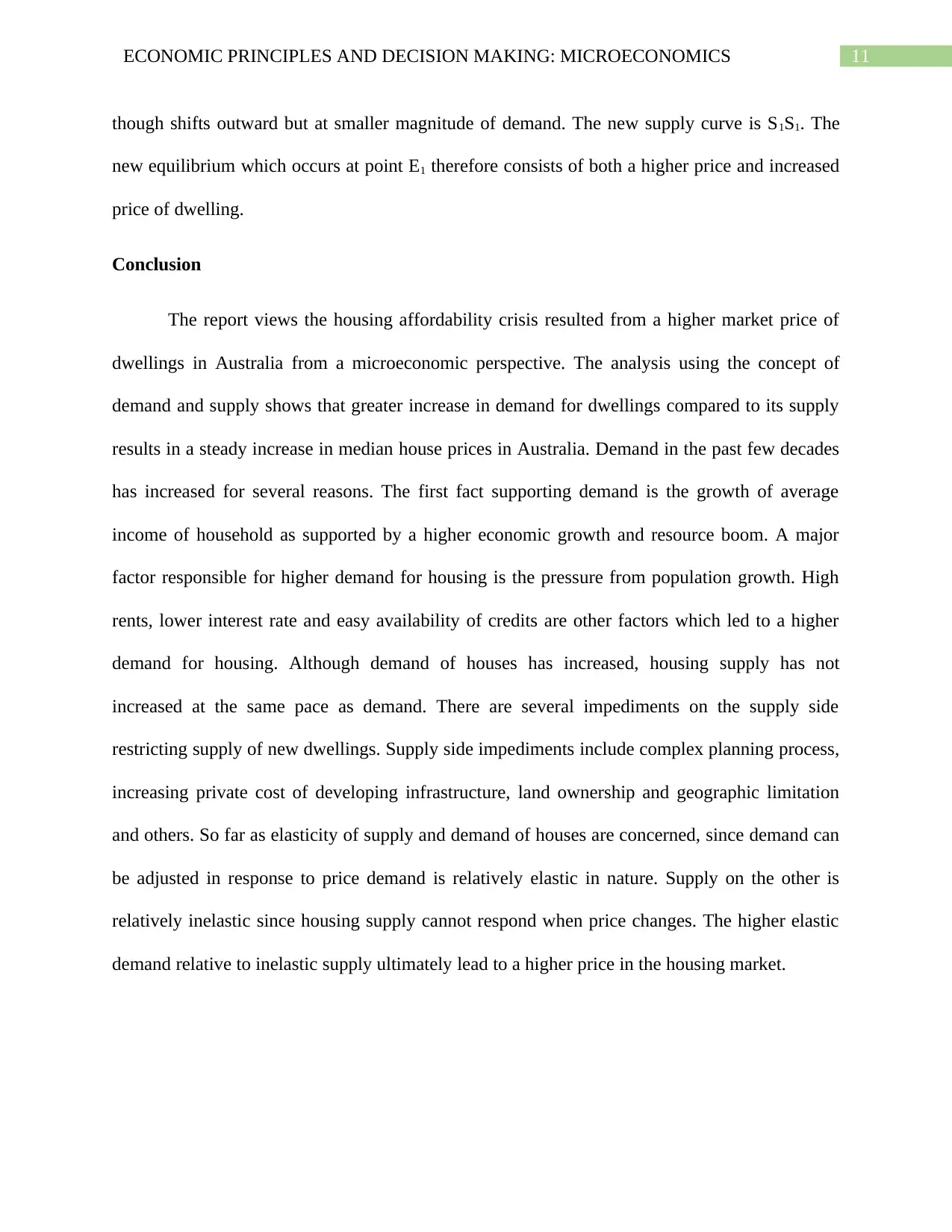
11ECONOMIC PRINCIPLES AND DECISION MAKING: MICROECONOMICS
though shifts outward but at smaller magnitude of demand. The new supply curve is S1S1. The
new equilibrium which occurs at point E1 therefore consists of both a higher price and increased
price of dwelling.
Conclusion
The report views the housing affordability crisis resulted from a higher market price of
dwellings in Australia from a microeconomic perspective. The analysis using the concept of
demand and supply shows that greater increase in demand for dwellings compared to its supply
results in a steady increase in median house prices in Australia. Demand in the past few decades
has increased for several reasons. The first fact supporting demand is the growth of average
income of household as supported by a higher economic growth and resource boom. A major
factor responsible for higher demand for housing is the pressure from population growth. High
rents, lower interest rate and easy availability of credits are other factors which led to a higher
demand for housing. Although demand of houses has increased, housing supply has not
increased at the same pace as demand. There are several impediments on the supply side
restricting supply of new dwellings. Supply side impediments include complex planning process,
increasing private cost of developing infrastructure, land ownership and geographic limitation
and others. So far as elasticity of supply and demand of houses are concerned, since demand can
be adjusted in response to price demand is relatively elastic in nature. Supply on the other is
relatively inelastic since housing supply cannot respond when price changes. The higher elastic
demand relative to inelastic supply ultimately lead to a higher price in the housing market.
though shifts outward but at smaller magnitude of demand. The new supply curve is S1S1. The
new equilibrium which occurs at point E1 therefore consists of both a higher price and increased
price of dwelling.
Conclusion
The report views the housing affordability crisis resulted from a higher market price of
dwellings in Australia from a microeconomic perspective. The analysis using the concept of
demand and supply shows that greater increase in demand for dwellings compared to its supply
results in a steady increase in median house prices in Australia. Demand in the past few decades
has increased for several reasons. The first fact supporting demand is the growth of average
income of household as supported by a higher economic growth and resource boom. A major
factor responsible for higher demand for housing is the pressure from population growth. High
rents, lower interest rate and easy availability of credits are other factors which led to a higher
demand for housing. Although demand of houses has increased, housing supply has not
increased at the same pace as demand. There are several impediments on the supply side
restricting supply of new dwellings. Supply side impediments include complex planning process,
increasing private cost of developing infrastructure, land ownership and geographic limitation
and others. So far as elasticity of supply and demand of houses are concerned, since demand can
be adjusted in response to price demand is relatively elastic in nature. Supply on the other is
relatively inelastic since housing supply cannot respond when price changes. The higher elastic
demand relative to inelastic supply ultimately lead to a higher price in the housing market.
⊘ This is a preview!⊘
Do you want full access?
Subscribe today to unlock all pages.

Trusted by 1+ million students worldwide
1 out of 15
Related Documents
Your All-in-One AI-Powered Toolkit for Academic Success.
+13062052269
info@desklib.com
Available 24*7 on WhatsApp / Email
![[object Object]](/_next/static/media/star-bottom.7253800d.svg)
Unlock your academic potential
Copyright © 2020–2025 A2Z Services. All Rights Reserved. Developed and managed by ZUCOL.





